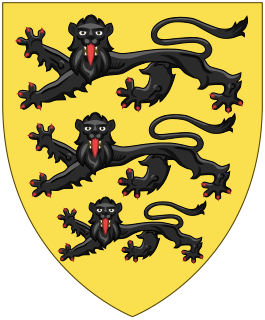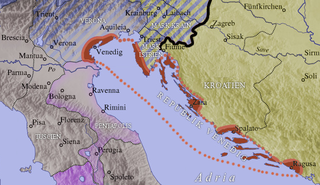Related Research Articles

The Hohenstaufen, also called Staufer, was a noble dynasty of unclear origin that rose to rule the Duchy of Swabia from 1079 and to royal rule in the Holy Roman Empire during the Middle Ages from 1138 until 1254. The most prominent kings Frederick I (1155), Henry VI (1191) and Frederick II (1220) ascended the imperial throne and also ruled Italy and Burgundy. The non-contemporary name is derived from a family castle on the Hohenstaufen mountain at the northern fringes of the Swabian Jura near the town of Göppingen. Under Hohenstaufen reign the Holy Roman Empire reached its greatest territorial extent from 1155 to 1268.

The Duchy of Carinthia was a duchy located in southern Austria and parts of northern Slovenia. It was separated from the Duchy of Bavaria in 976, and was the first newly created Imperial State after the original German stem duchies.

The House of Zähringen was a dynasty of Swabian nobility. Their name is derived from Zähringen castle near Freiburg im Breisgau.

Swabia is a cultural, historic and linguistic region in southwestern Germany. The name is ultimately derived from the medieval Duchy of Swabia, one of the German stem duchies, representing the territory of Alemannia, whose inhabitants interchangeably were called Alemanni or Suebi.
The Dukes of Swabia were the rulers of the Duchy of Swabia during the Middle Ages. Swabia was one of the five stem duchies of the medieval German kingdom, and its dukes were thus among the most powerful magnates of Germany. The most notable family to rule Swabia was the Hohenstaufen family, who held it, with a brief interruption, from 1079 until 1268. For much of this period, the Hohenstaufen were also Holy Roman Emperors. With the death of Conradin, the last Hohenstaufen duke, the duchy itself disintegrated, although King Rudolf I attempted to revive it for his Habsburg family in the late-13th century.

Alamannia or Alemannia was the territory inhabited by the Germanic Alemanni peoples after they broke through the Roman limes in 213. The Alemanni expanded from the Main River basin during the 3rd century, raiding Roman provinces and settling on the left bank of the Rhine River beginning in the 4th century.
Conrad, called the Red, was Duke of Lorraine from 944 until 953. He became the progenitor of the Imperial Salian dynasty.
Ulrich, is a German given name, derived from Old High German Uodalrich, Odalric. It is composed of the elements uodal- meaning "(noble) heritage" and -rich meaning "rich, powerful". Attested from the 8th century as the name of Alamannic nobility, the name is popularly given from the high medieval period in reference to Saint Ulrich of Augsburg.

Berthold II, Duke of Carinthia, also known as Berthold I of Zähringen, was a progenitor of the Swabian House of Zähringen. From 1061 until 1077, he was the Duke of Carinthia and Margrave of Verona.

The Duchy of Swabia was one of the five stem duchies of the medieval German Kingdom. It arose in the 10th century in the southwestern area that had been settled by Alemanni tribes in Late Antiquity.
Henry III, called the Younger, a member of the Luitpolding dynasty, was the first Duke of Carinthia from 976 to 978, Duke of Bavaria from 983 to 985 and again Duke of Carinthia from 985 to 989.
Burchard I, a member of the Hunfriding dynasty, was a Duke of Alamannia from 909 until his death. He also held the title of a margrave of Raetia Curiensis, as well as count in the Thurgau and Baar.
Humfrid was the Count of Barcelona, Girona, Empúries, Roussillon, and Narbonne from 858 to 864. He also bore the title Margrave of Gothia, as he held several frontier counties.

The Marchof Carniola was a southeastern state of the Holy Roman Empire in the High Middle Ages, the predecessor of the Duchy of Carniola. It corresponded roughly to the central Carniolan region of present-day Slovenia. At the time of its creation, the march served as a frontier defense against the Kingdoms of Hungary and Croatia.
Hunfrid was the Margrave of Istria and, according to some sources, Duke of Friuli from 799 to c. 804, when a Duke John was ruling Istria. He was the founder of the family called the Hunfridings.

The March of Istria was originally a Carolingian frontier march covering the Istrian peninsula and surrounding territory conquered by Charlemagne's son Pepin of Italy in 789. After 1364, it was the name of the Istrian province of the Habsburg Monarchy, the Austrian Empire and Austria-Hungary.

The House of Andechs was a feudal line of German princes in the 12th and 13th centuries. The Counts of Dießen-Andechs obtained territories in northern Dalmatia on the Adriatic seacoast, where they became Margraves of Istria and ultimately dukes of a short-lived imperial state named Merania from 1180 to 1248. They were also self-styled lords of Carniola.
Theodoric I was a nobleman in the Duchy of Saxony.

Agnes of Rochlitz came from the Wettin family and was daughter of Dedi III, Margrave of Lusatia and his wife, Matilda of Heinsburg. She is also known as Agnes of Wettin.
The Duchy of Thuringia was an eastern frontier march of the Merovingian kingdom of Austrasia, established about 631 by King Dagobert I after his troops had been defeated by the forces of the Slavic confederation of Samo at the Battle of Wogastisburg. It was recreated in the Carolingian Empire and its dukes appointed by the king until it was absorbed by the Saxon dukes in 908. From about 1111/12 the territory was ruled by the Landgraves of Thuringia as Princes of the Holy Roman Empire.
References
- Reuter, Timothy. Germany in the Early Middle Ages 800–1056. New York: Longman, 1991.